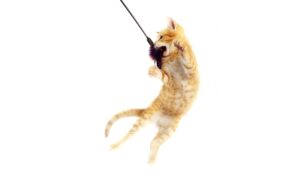Senior Solutions: Support for Older Pets
Chris Junior //November 6, 2019//
November is Adopt a Senior Pet Month, and it serves as an annual reminder that plenty of older cats, dogs and other animals await at shelters and rescue centers across America for a permanent home. Keeping senior pets healthy and active around the home, however, matters every month. In order to help maintain pets’ quality of life during their advanced years, owners should be on the lookout for changes in actions and behavior, then respond with products, services and veterinary appointments to address the issues.
For owners and retailers, it’s important to have an idea what constitutes a senior pet to minimize guesswork for purchases and services. According to the American Veterinary Medical Association (AVMA), senior status would be seven years for cats and small dogs, while larger dog breeds achieve the senior distinction a year or two earlier.
With other animals, though, senior classification is not nearly as specific in terms of age.
“From the [exotic] species I treat, it’s so much harder because a canary might live five or six years and a macaw might live 50 [years],” said Dr. Laurie Hess, owner and medical director at the Veterinary Center for Birds & Exotics in Bedford Hills, New York, in the November 2018 Pet Age cover story.
Nevertheless, “age is not a disease” and “pets are living longer now than they ever have before,” the AVMA writes on its website. “Although senior pets may develop age-related problems, good care allows them to live happy, healthy and active lives in their senior years.”
Help for Cats
It’s a fact that animals and humans go through similar age-related health issues, but pets need their owners to be observant and act on their behalf when such problems arise.
One mutual malady is osteoarthritis, which is the breaking down of cartilage in joints. According to the FDA, osteoarthritis is commonly recognized in dogs, but physically diagnosing cats with it “is difficult even for experienced veterinarians” due in part to cats’ dislike for being handled during examinations. As such, vets “simply rely on the cat owner’s observations that their pet is not moving around as well as it once did,” the FDA adds.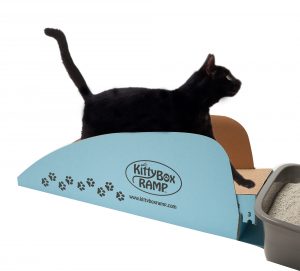
With osteoarthritis in cats commonly affecting the elbows and hips, and to a lesser extent the shoulders and hocks, it’s understandable that older felines challenged by navigating a litter box with high sides or an elevated opening would start doing their business on the floor. To help overcome that, there’s the Kitty Box Ramp, the brainchild of Jennifer Baker-Johnson and her husband, Dean Johnson. They came up with the idea for it in 2015 when their cat Sam, suffering from arthritis in her back legs, had problems accessing the litter box. Made of 100 percent recycled corrugated cardboard, the Kitty Box Ramp has reinforced walls and comes with tread pads, which are adhered to the walkway for better paw traction. The ramp can be adjusted to three different heights and accommodate cats up to 20 pounds.
“Unfortunately, Sam passed during the beginning stage of our prototype process, so we brought this to market in Sam’s honor,” Baker-Johnson said. “We knew there were many pet parents out there like us who were looking for something to make life easier for their fur babies.”
Kidney disease and urinary tract issues can develop in older cats, and those ailments may impact what ends up in a litter box or whether a cat uses the litter box at all.
With older felines in mind, Dr. Elsey’s, makers of specialized litters and food for cats, introduced its Senior Litter in May 2007.
“Senior cats are more likely than younger cats to develop urinary tract infections as a result of not being able to keep their genital area clean and having more diluted urine,” explained Gina Zaro, marketing director for Dr. Elsey’s.
Just as entering a litter box can be problematic for older cats, so is getting into position once they are inside, said Zaro, “especially in deep litter, which is typically three to four inches.” Made with an amorphous silica gel that absorbs urine on contact, Senior Litter can be kept shallow, about one inch—“thus preventing a cat from getting litter and feces on their genital area,” Zaro added.
Kidney complications can play a part in an older cat losing weight, according to the Cornell University College of Veterinary Medicine. Weight gain may occur at this stage of life as well due to other issues, so no matter which way a pet is trending on the scale, attention must be paid to eating habits along with the nutritional values of foods being served.
Within the divisions of its Pro Plan line, Purina has offerings meant for cats well into their senior years, and among the ingredients are vitamins A and E, which provide immune system support. Prime Plus contains dry and canned foods for ages 7 and older, and there are two canned Focus varieties for ages 11 and up.
Merrick has three senior-specific dry cat foods, each one touting its protein, a key source of energy and an important nutrient for felines at all stages of life. Made with deboned chicken, the Purrfect Bistro Indoor Senior Recipe has a 65 percent protein level, while the Purrfect Bistro Healthy Senior Recipe tops out at 70 percent. With a crude protein level of 38 percent, the Backcountry Raw Infused Mature Recipe features glucosamine and chondroitin, and for cats with hip and joint problems, these supplements can help diminish inflammation and prompt cartilage repair.
Around age 7, cats tend to have reduced energy needs, and weight gain can result if calorie intake is not adjusted, says Dr. Ginny Bischel of Eastlake Village Veterinary Clinic in California.
“They will also start to have changes in muscle mass,” Dr. Bischel added. “Sometimes cats that are sick may lose lean muscle mass despite an abundance of body fat. So first it is important to do a complete evaluation of what the pet is currently eating—which specific diet, what treats it gets… what food is used to administer medications. Are they being free fed? Do they share a bowl with other cats? This is all key in determining a dietary recommendation.”
Help for Dogs
Osteoarthritis has been among the canine conditions most researched by veterinarians going back to at least 2006, according to the Journal of the American Veterinary Medical Association. Since then, products—some influenced by owners’ personal experiences with older animals facing age-related problems—have emerged to help with alleviating discomfort and assisting with mobility.
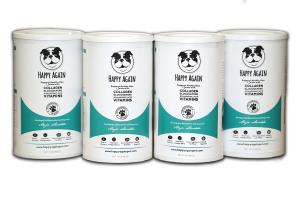 Anja Skodda would take her nearly 8-year-old bulldog Tony outside every night so he could ride his skateboard, but when he developed stiffness in his shoulders about four years ago, that activity came to an abrupt end.
Anja Skodda would take her nearly 8-year-old bulldog Tony outside every night so he could ride his skateboard, but when he developed stiffness in his shoulders about four years ago, that activity came to an abrupt end.
Skodda, whose background is in biotech engineering, had already spent several years conducting cartilage-related research, so she applied her knowledge to develop a joint supplement formula for dogs, working with a veterinarian to determine the correct dosage.
After about a week of taking her dried powder mixture, Tony “was a new dog—even better than [before] the shoulder issue,” recalled Skodda.
Released in the U.S. in January, Skodda’s Happy Again supplement features high-grade collagen, hyaluronic acid, glucosamine and vitamins for collagen rebuilding and better mobility. The company is set to introduce a liquid version next year, along with a chew stick that comes with a scoop of the powder in a treat.
“If you want to prevent [cartilage breakdown], you should start very early with the supplement,” said Skodda. “I don’t recommend waiting until you have a senior dog and saying, ‘Oh, he has an issue’… We try to educate people that they should start early on.”
Early in her life, a Golden Retriever in Colorado named Ginger with hip dysplasia underwent a triple pelvic osteotomy on her right hip, then had surgery for a luxating patella on her back left knee. Following the second procedure, owners Liz and Barry Rubinstein, inspired to provide Ginger with better support and restraint while she recovered, invented a product dubbed the GingerLead.
“It’s basically crutches for dogs,” Liz Rubinstein said in 2016 during an appearance on the “Colorado’s Best” TV show. “It’s a nice, soft, padded belly sling… it has a Velcro handle for the owner to hold onto and stand up straight… and it has the leash attached [from the handle to the collar].”
Dogs with arthritis and other age-related conditions may benefit from using the GingerLead. “For dogs already unsteady on their feet, the GingerLead can help rehabilitate their legs by providing balance or support while you walk them,” according to the company site.
Ten years ago, after her dachshunds Henry and June were diagnosed with intervertebral disc disease, Lisa Luckenbach designed the WiggleLess Dog Back Brace, a unisex device available in four sizes.
“I refused to watch them suffer,” Luckenbach said on the Lisa Story’s page of her company’s website. “I created WiggleLess Dog Back Brace so that they could live a fulfilling life. My mission is to provide you and your dog the same comfortable, firm back support and the accompanying peace of mind.”
Inspired by his late dog Mercedes, who at eight years old was diagnosed with canine epilepsy, Mark C. Robinson in 2001 founded Walkin’ Pets by HandicappedPets.com, which he says was primarily intended to be a discussion board for people who were caring for aging, injured and disabled animals.
In the ensuing years, he took note of the products being talked about and zeroed in on finding ways to improve dog wheelchairs.
“As much as these devices were loved, they just didn’t work too well,” Robinson said. “There were some real flaws. They took three to four weeks to build custom for the dog. They had to take 13 measurements of their dog; it was worse than getting fitted for a suit.”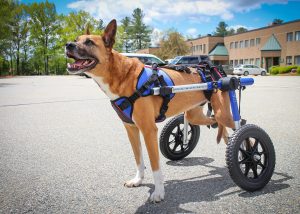
The Robinson-designed Walkin’ Wheels wheelchairs, the first model of which arrived in 2008, only require one or two measurements to get the correct frame-wheel combination for a dog. The push-button adjustability of height, length and width makes the rear and quad wheelchair models suitable for senior dogs dealing with physical changes.
“Many diseases of elderly dogs are degenerative, which means that when it starts out, a dog is a little bit weak—they can still walk and take a few steps, but then they fall,” Robinson explained. “So at this point they need a wheelchair that lets them put their feet on the ground. As the disease moves forward, they need their feet off the ground, so they need a wheelchair that keeps them a little higher.”
“Wheelchair adjustability is great,” he adds, “but if you can’t fit it into your car, you can’t take your dog to the dog park.” Robinson designed the Walkin’ Wheels wheelchairs so they could fold flat for easy storage in vehicles, resulting in a setup time upon arrival at a destination that he says can be as short as five minutes.
For those trips to the park or walks around the block, canines in their advanced years still need sufficient energy. At the same time, due to a slower metabolism and decreased physical activity, older dogs require 20 percent fewer calories than middle-age adult dogs, according to a guide produced by the National Research Council of the National Academies in Washington, D.C. So for senior dog owners looking to transition their pets to senior-specific foods, it’s wise to check the labeling on cans and bags for calorie counts and feeding guidelines.
Merrick offers Grain Free Senior Real Chicken + Sweet Potato Recipe dry food for all dog breeds, and on its website, there is a Quick Calorie Estimator where users can select the senior option, then choose the activity level and ideal weight in order to find out the recommended kilocalories per day.
Fromm Family Foods’ senior recipes “take into account the slower metabolic rate of a less-active dog,” brand director Bryan Nieman told Pet Age for its May/June cover story. Within its senior portfolio for dogs is Reduced Activity & Senior Gold dry food, made with chicken, probiotics and other ingredients. Consumers can use the daily feeding recommendations chart on its website, and they are also welcome to email their pets’ age, breed, weight and other details to Fromm to determine “a good starting point based on your pet’s nutritional needs.”
Ark Naturals has produced the Gray Muzzle series of soft chews for senior dogs for five years, and CEO Michael Stoeckle says this product line gets more consumer engagement than any other segment in the company’s portfolio.
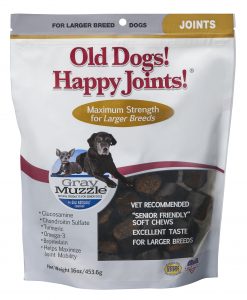 Five years is the age at which Ark Naturals recommends giving Gray Muzzle chews to dogs (they’re also good for cats).
Five years is the age at which Ark Naturals recommends giving Gray Muzzle chews to dogs (they’re also good for cats).
“We work with our advisory council to determine these types of specific details for all of our products,” explained Stoeckle. “Most veterinarians will tell you seven years of age is considered ‘senior’ in the dog world. However, if you begin a regimen of taking the products prior to absolute need, it should help with specific indications or issues that may arise.”
Help for Other Pets
Senior reptiles make for great pets, “as they have been around the block and are a lot more forgiving when handled and readily eat usually right out of your hand or in front of you,” said Loren Leigh, owner of LLLReptile and Supply Company, which has stores in California and Nevada.
But when it comes to what older reptiles eat, owners can expect to “fine-tune their feeding” during this stage of life, he adds.
“Many foods made now by manufacturers like Fluker’s, Zilla, Zoo Med and Exo Terra have a juvenile or baby option and an adult option,” Leigh said. “They have balanced the food ingredient panels to better suit reptiles’ growth. [A good example is] Zoo Med turtle diets and the many different pellet sizes and protein levels as the turtle goes from hatchling to juvenile to adult.”
Beyond food, Leigh emphasizes specific habitat décor items for older reptiles.
“There are many types of branches that have big platforms for easier basking, water bowls that are low or have a ramp for easy access and sturdy wood pieces to make sure cage materials don’t topple over,” he said.
Whether it’s a senior cat, dog, turtle or another animal, Dr. Bischel says retailers can contribute to older pets staying healthy and active while catering to their owners by stocking consumable products made with raw materials sourced and manufactured in the United States.
“As veterinarians, we are always asked by clients what commercial diets, treats and supplements we recommend and where they should purchase them,” she said. “I like to have the confidence in knowing that I can recommend a retailer to my clients that provides quality products because it takes teamwork to keep older pets happy and healthy.”










